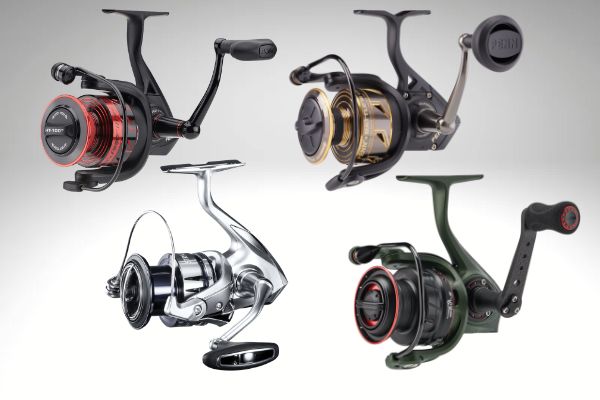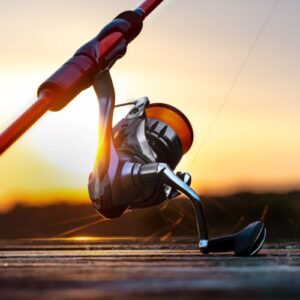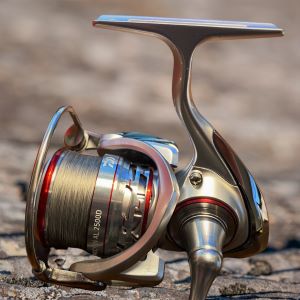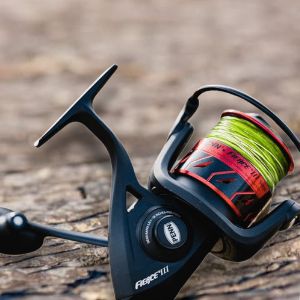The Shimano Stradic is one of the best spinning reels ever made, and it has developed a cult like following of fans. It is simply a well-built reel that is not only smooth but extremely durable.
If there is one complaint regarding the Stradic it is the price, at close to $200 it is a lot of money to spend on a fishing reel. So looking for alternatives can make a lot of sense.
What makes the Stradic special?
Let’s first discuss what makes the Shimano Stradic such a special reel. That is simple, it is lightweight, smooth, and tough. In my experience, unless you thrash and mistreat them they basically last forever.
But to get into specifics, it has to be the full metal frame. What other 1000 size spinning reel with a full metal frame weighs in at just 6.5oz, even the 2500 size weighs only 7.9oz. That is lighter than some carbon frame reels.
Is a metal frame reel actually better than carbon?
Check my other guide for a selection of recommended carbon frame reels
Is metal better than fancy plastic? From a purely objective standpoint, carbon does seem to have a lot going for it. After all, it does not corrode and is extremely rigid for its weight. Carbon frames are also cheaper to manufacture than metal, resulting in more affordable reels.
With that said, for many of us metal frame reels simply feel better. They feel more solid, and more premium. They feel like a reel, not like a toy. Sure, they can corrode, but with proper care and the occasional wash that is not really an issue.
Metal reel frames are also much more impact resistant, and there is zero chance they will ever become brittle due to spending too long in the sun.
So metal frame reels are not inherently better, but many of us still prefer them.
Overview of metal frame reels?
Aluminum:
Most metal frame spinning reels are made from Aluminum
It is lightweight, impact-resistant, and offers good rigidity. The downside is that aluminum frames can suffer from corrosion. Although with good maintenance, and most importantly washing away any saltwater corrosion should not be a major issue.
Magnesium. Magnesium is found on some more premium reels, it is a popular choice because it weighs 33% less than aluminum, although due to it being less strong, more is required to make a reel rigid.
This counteracts any weight savings. Magnesium does corrode and for this reason it is rarely used in saltwater reels.
How about the Shimano Vanford?
The Vanford is basically a Stradic with a carbon body, while some of the parts are different they are very similar reels. Yes, the Vanford is even lighter. It is a gem of a reel. If you want a Stradic with a carbon body, and the price is not an issue get a Vanford.
How about the Shimano Stellar?
The Stellar, and other more premium reels in Shimano’s lineup are better reels, but they cost significantly more, and unless you are pushing your gear to the absolute limits. They have also replaced many of the internal brushings with ball bearings. Stellars are engineering perfection.
With that said, for freshwater applications, there is very little on the water performance difference between a Stradic and the truly high end offerings. If you have the money, the Stellar is a better reel.
I mean, for very demanding applications. Like jigging for tuna, or casting poppers for hard fighting saltwater pelagics, then the cost of a stellar might be justifiable. But there is not really going to be any difference when fishing for trout or bass.
Reel Weight Comparison
| Reel Size | 1000 (100ys/6lb) | 2500 (140ys/8lb) | 4000 (200ys/10lb) |
|---|---|---|---|
| Penn Fierce | 7.8 | 9.5 | 12.5 |
| Penn Battle | 7.8 | 9.4 | 12.2 |
| Daiwa BG | 8.5 | 9.3 | 10.8 |
| Abu Garcia Zata | 8.1* | 8.5 | 9.5 |
| Daiwa Procyon AL | 7.8 | 8.3 | |
| Shimano Stradic FL | 6.5 | 7.9 | 9.9 |
In the chart above, I did my best to compare the weight of similar line capacity reels.
This is a bit challenging because there is no uniform way to measure reel size. For example, a 1000 size Shimano is different from a 1000 size Daiwa.
Daiwa reels also typically offer larger spool capacity for any given size of reel. The smallest Daiwa, has a capacity of 220yds of 6lb despite being smaller than some reels that only offer 110yd of 6lb.
So, in the ultralight category. The Shimano Stradic FL is in a class of its own, none of its competitors have a reel under 7oz that holds 100yds of 6lb. This is the reason why I consider it to be the ultimate ultralight reel.
In the 2500 size category or reels that can hold approximately 140 yards of 8lb yards, there is a lot more competition. With both the Daiwa Procyon being ever so slightly lighter. I will note here, that the Procyon competes in the same price range as the Stradic, it is not a cheaper reel.
Finally, in the 4000 size range reels ( 200 yards of 10lb monofilament), the Stradic is heavier than both the Procyon and the Abu Garcia Zata.
Comparing drags.
| Reel Size | 1000 (100ys/6lb | 2500 (140ys/8lb) | 4000 (200ys/10lb) |
|---|---|---|---|
| Penn Fierce | 9 | 10 | 15 |
| Penn Battle | 9 | 10 | 15 |
| Daiwa BG | 4.4 | 13.2 | 15.4 |
| Abu Garcia Zata | 14 | 14 | 14 |
| Daiwa Procyon AL | 11 | 22 | |
| Shimano Stradic FL | 7 | 20 | 24 |
While I just listed maximum drag pressures above, there is more finesse to comparing drags than just comparing maximum numbers. A powerful drag is not necessarily a good thing when fishing ultralight lines. For example, there is also no need for 15lb of drag pressure when fishing 4lb line.
I also want to bring up minimal drag pressure, which is the minimal amount of pressure it takes for a drag to start working. Drags that are too powerful, can sometimes fail to initiate smoothly. This increases the chance of line breaking.
To be honest, the drags on all of the reels are fine when new, and fully serviced.
The Daiwa BG, in my opinion at least has the best optimized drag in the 1000 size section. It is very smooth, the Stradic is also very nice.
The Zata uses a ‘off the shelf’ drag system that is found in many reels of a similar size, but it is nice and smooth, if a bit overkill. It really should not cause any problems if maintained.
With regards to the larger size drags, I actually Shimano and Daiwa have gone a bit overboard and installed too powerful of a drag, sure the frame can handle such pressures but if applied frequently it will speed up wear and tear and increases the risk of something breaking.
If they are fished with say 10lb braid, and the drag is kept light they are fine, but I just know someone is going to spool them up with 80lb rope then winch in a tree stump then wonder why their main shaft bets bent and the gearbox ends up out of alignment.
Ball Bearings
| Reel Size | 1000 (100ys/6lb) | 2500 (140ys/8lb) | 4000 (200ys/10lb) |
|---|---|---|---|
| Penn Fierce | 5 | 5 | 5 |
| Penn Battle | 6 | 6 | 6 |
| Daiwa BG | 7 | 7 | 7 |
| Abu Garcia Zata | 11 | 11 | 11 |
| Daiwa Procyon AL | 7 | 7 | 7 |
| Shimano Stradic FL | 7 | 7 | 7 |
I know fishermen love ball bearings, so here is the comparison table. Not much difference, except for Abu Garcia who tried to squeeze in as many as possible.
There is not really much to add, it is sometimes possible to replace brushing with additional ball bearings, but it does not really change much, because any resistance is usually caused by imperfections in the gearing.
Some people like to replace bearings with higher quality ceramic ones, in baitcaster style reels this can increase casting distance, but because the spool is fixed in spinning reels it is not possible to increase casting distance in the same way.
I suppose I could discuss the bearings themselves.
The Penn fierce, and the Abu Zata use standard stainless steel ball bearings, they are fine when kept dry and properly lubricated. The Battle gets slightly better-quality sealed bearings.
Daiwa uses shielded bearings from Minebea in the BG. I have no way to test this, but apparently, they have better tolerances. I do not currently have a Procyon in my position, so can not check what bearings are inside.
The Stradic Shimano uses good quality shielded anti-rust bearings. Not the best bearing on the market, but certainly up to the task.
Casting performance
All six reels cast well, and have excellent to very good line lay.
All six have optimized spools to minimize friction during the cast,
The best performers were the Stradic when casting monofilament, and the Procyon when casting braid.
Even the two Penns have managed to sort out their line lay issues that plagued previous generations. They do not cast quite as far, but they do so without any problems.
I also have no complaints regarding the Abu, it is a very nice casting reel and the line simply flies off. Due to the slightly smaller spool, it is not quite as good as the Stradic or Daiwa’s but still a joy to use.
Editors Choice: Shimano Stradic
The Shimano Stradic is a classic Spinner reel that has never failed to impress. Every generation offers evolutionary improvements to the previous.
The Stradic is the best metal frame spinning reel that weighs under 7oz, in fact, it weighs less than many competing carbon frame reels.
It is best in class at handling monofilament which allows it to cast a few extra feet in casting distance.
If treated with respect, and not used as a winch. The Stradic should offer many years of faithful service.
Runner up: Daiwa Procyon AL
The Daiwa Procyon is an excellent metal frame alternative to the Shimano Stradic.
It is lighter than the Stradic in larger sizes which makes it a compelling choice for lightweight fishing applications. It is ideal for Salmon, Steelhead, or inshore fishing.
The oversize spool allows for longer than average casts, and the linelay prevents the braided line from digging into itself allowing for smoother casts.
Best value: Penn Fierce
The Penn Fierce offers incredible value for money, and it shares many parts in common with its more expensive sibling the battle.
The line management on the Fierce is as good as anything from Daiwa or Shimano, and it comes with the same drag system as Penns premium reels.
The fierce is built around a solid, and surprisingly rigid frame that is designed to take the occasional knock. The quality of the internal gearing belies its low price. If you can not afford a Stradic, buy a Penn.
Summary
Guess it is time to summarize this article.
Best ultralight metal frame reel
I feel in the ultralight reel segment, the Stradic is basically in a class of its own. No other metal frame reel really comes close to offering the performance-to-weight ratio that the Stradic does. So if you are in the market for an ultralight metal frame spinning reel, that weighs under 7oz then the Stradic 1000 size is the only option.
If money is short, I can not believe I am writing this then the Penn Battle or its cheaper sibling the Fierce are worthy alternatives. While they lack some of the refinements of the more expensive reels they still do the basics well and by all accounts, they are very reliable reels.
Best lightweight metal frame reel
This category is a bit more competitive with the Daiwa Procyon AL and the Stradic neck-to-neck. Both on paper, and on the water they are very similar reels. If you are a Daiwa fan, get the Procyon, if a Shimano fan get a Stradic.
Other than that, the line lay on the Shimano does favor monofilaments, while the criss-cross pattern of the line lay on the Procyon means it handles braid slightly better. Both are great reels.
Now, for a more budget-friendly recommendation. On paper, the Abu Garcia Zata looks very good, although its RRP is high. Although, I have seen it heavily discounted. So on sale, for use mainly in freshwater, it will certainly be a good choice.
For a cheap, general-purpose metal frame reel then the competition between the Battle and BG is intense. The battle seems to be slightly more reliable, but the BG does have a larger spool and is ever so better at casting and keeping line twists under control. My advice, go for the cheapest or the prettiest.




